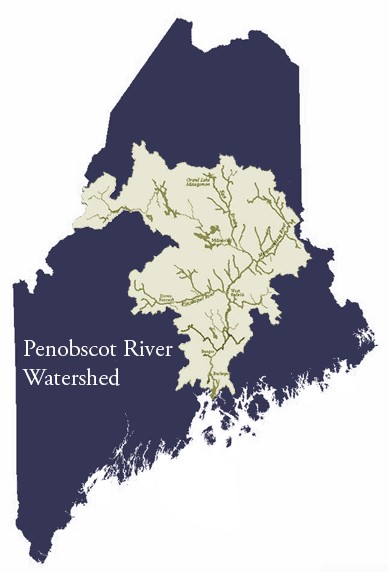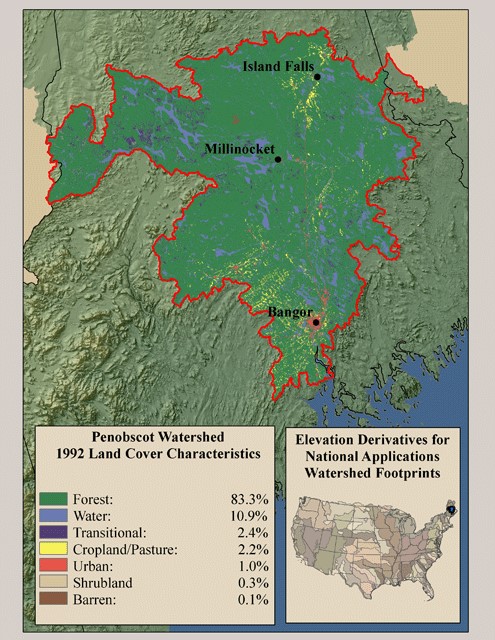- Home
- Spectralmass
- Rhessys
- Current Projects
Current Projects
Modelling DOC Flux from the Penobscot River Watershed, ME
Lead Investigator: Shabnam Rouhani
Our current research explores temporal trends in snowmelt timing, DOC flux and DOC concentrations from a forested watershed into a marine ecosystem by using the RHESSys hydrologic/biogeochemical model.

Warmer winters will likely produce earlier runoff with lower snow water equivalent due to reduced thickness of snowpack. Earlier runoff in the Penobscot River Watershed in the Spring changes seasonal water supplies for the entire ecosystem, causing large-scale events such as droughts in the summer.
How does climate change impact the timing and magnitude of snowmelt in New England and what does that mean for Maine environments?
Average temperature in New England has risen during 20th century, especially during the winter months (Hayhoe et al, 2007). Warmer winters will likely produce earlier runoff with lower snow water equivalent due to reduced thickness of snowpack. The response of streamflow timing and magnitude to warmer winters may be significant because a major component of the hydrology of river basins in New England involves snowpack and the timing of snowmelt (Dudley and Hodgkns, 2002). The New England’s climate characteristics such as near-freezing temperatures present in the late fall, winter, and early spring make New England Rivers sensitive to small changes in temperature. Moreover, the relative amount of precipitation falling as rain or snow directly affects the timing of river flow in these seasons while the largest river flows in New England typically are in the spring when rain falls on a ripe snowpack or on saturated soils.
Hydrological models are useful tools for understanding climate change in the New England region, as they allow predicting the possible response of hydrological parameters to changes in input conditions.
What are the Objectives of the Study?
- Apply the RHESSys model to study temporal trends in snowmelt timing in a forested watershed
- Model Dissolved Organic Carbon (DOC) from a forested watershed into a marine environment
- Compare the model with both in situ measurements and the results from another streamflow model.
- Explore the impact of various land use change scenarios on the export of DOC (amount) from a forested watershed into a marine environment.
Why the Penobscot River Watershed?
There are several lakes and reservoirs located in Penobscot Watershed in Maine. An earlier snowmelt runoff in this region could threaten storage efficiencies in the area. In addition, an advance in snowmelt runoff would also increase the length of the summer drought with important consequences for the water supply of ecosystem. So all in all, the Penobscot watershed ‘s characteristics both climate and land cover makes it important to study temporal trends in snowmelt timing based on climate change projections.
What is DOC?
Dissolved organic carbon (DOC) is an important component of the global carbon cycle with variations linked to changes in terrestrial carbon storage. The flux of Dissolved Organic Carbon (DOC) from the terrestrial system to the aquatic system is a fundamental part of the global carbon cycle. DOC affects the aquatic ecosystem by attenuating radiation to protect the aquatic biota in the surface layer from UV radiation and at the same time serving to shade the aquatic biota in the lower layer of water (Boeing et al. 2004; Williamson and Zagarese 1994). DOC concentrations in riverine stream channels also impact the water quality and thus directly impact the health of both anthropogenic and natural communities in a watershed (Delpla et al. 2009; Siddiqui et al. 1997).
Because of the difficulty in obtaining frequent field measurements and lack of consistency between laboratory studies and field measurements, our knowledge of the DOC in soil and the DOC flux from the terrestrial to aquatic systems is still fragmentary (Kalbitz et al. 2000). Using Regional Hydro-Ecological Simulation System (RHESSys) gives us the opportunity to explore the details of the Penobscot Watershed biogeochemistry.
In large, heterogeneous catchments, stream water DOC dynamics are regulated by the combined effects of hydrological mechanisms and the proportion of major landscape elements, such as wetland and forested areas.
How does land-use in the watershed effect DOC flux, and why is land coverage important for our model?
Previous studies have shown that different vegetation types have different effects on fluvial DOC export. Also, a number of studies have demonstrated that the amount of wetlands, especially peatlands, controls watershed level transport of DOC in streams (e.g. Gergel et al. 1999, Kolka et al. 1999).
Our model builds off these previous studies to explore the effect of land cover change on DOC flux, particularly in relation to vegetation type and wetland disturbance.

Citations
- Hayhoe, K.; Wake, C.P.; Huntington, T.G.; Luo, L.; Schwartz, M.D.; Sheffield, J.; Wood, E.; Anderson, B.; Bradbury, J.; DeGaetano, A.; Troy, T.J.; Wolf, D. 2007. Past and future changes in climate and hydrological indicators in US Northeast. Climate Dynamics.
- Hodgkins, G. A., R. W. Dudley. Trends in Streamflow, River Ice, and Snowpack for Coastal River Basins in Maine During the 20th Century. U.S. GEOLOGICAL SURVEY: Water-Resources Investigations Report
- Yang, Yun, "Studying Soil Moisture and Land-to-Water Carbon Export in Urbanized Coastal Areas Using Remotely Sensed Data and a Regional Hydro-Ecological Model" (2013). Graduate Doctoral Dissertations
- Williamson CE, Zaragese HE, Schulze PC, Hargreaves R, Seva J (1994) The impact of short-term exposure of UV-B radiation on zooplankton communities in north temperate lakes. J Plankton
- Wiebke J. Boeing . Dina M. Leech. Craig E. Williamson . Sandra Cooke . Lisette Torres. Damaging UV radiation and invertebrate predation: conflicting selective pressures for zooplankton vertical distribution in the water column of low DOC lakes
- Delpla, I. Jung, A.-V., Baures, M., Thomas, O. 2009. Impacts of climate change on surface water quality in relation to drinking water production. Environment International, vol 38(8), 1225-1233
- Siddiqui, M.S., Amy, G.L., & Murphy, B.D. (1997). Ozone enhanced removal of natural organic matter from drinking water sources. Water Research, 31, 3098-3106
- Kalbitz, K., Solinger, S., Park, J.H., Michalzik, B., & Mather, T.N. (2000). Controls on the dynamics of Dissolved Organic Matter in soils: a review. Soil Science, 165, 277-304
- Sarah E. Gergel, Monica G. Turner, and Timothy K. Kratz. (1999). Dissolved Organic Carbon as an indicator of the scale of Watershed influence on lakes and rivers
- Kolka RK, Grigal DF, Verry ES, Nater EA (1999) Mercury and organic carbon relationships in streams draining forested uplandpeatland watersheds. Journal of Environmental Quality 28: 766775
Professor Crystal Schaaf’s Lab
University of Massachusetts Boston
100 Morrissey Blvd.